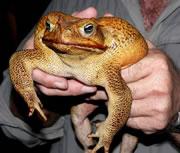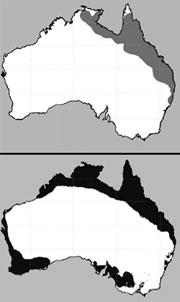 Poisonous, fast-breeding invaders: this particularly big toad, found this week, is a giant pest.AP/PA Photos
Poisonous, fast-breeding invaders: this particularly big toad, found this week, is a giant pest.AP/PA PhotosSince cane toads were introduced to Australia in 1935, they have colonized 1.2 million square kilometres of that country — an area greater than that of France and Spain combined. But they might just be getting started, says an analysis that suggests they could double their current range.
The toads' spread seems to be partly due to their ability to adapt to survive in a broader range of climates. If that trend continues, then the area at risk from the toads could be even larger. "If they are evolving then our current predictions may be conservative," says ecologist Mark Urban of the University of California, Santa Barbara. "In ten years, we may be presenting a greatly expanded model of suitable habitat."
The cane toad (Bufo marinus) currently occupies a swathe of Australia's tropical east and north, roughly from Brisbane to Darwin. This area is already larger than what was predicted based on the toad's normal environment in its home range in South and Central America: it has moved into places both hotter and cooler than American toads can tolerate.
To get an idea of how much further the toads might spread, Urban's team divided the country into squares of approximately 2.7 square kilometres, looked at the climate in each square, and compared that with the areas already containing toads.
“They have an uncanny ability to hide out in trucks and airplanes.”
Mark Urban of the University of California, Santa Barbara
The model suggested that about 2 million square kilometres of Australia is toad-friendly, they report in Proceedings of the Royal Society B1. The untapped habitat lies in temperate, coastal regions of western and southern Australia - around Perth and Adelaide, for example. That may seem a long way from where they are now, but the toads could get there, says Urban: "They have an uncanny ability to hide out in trucks and airplanes."
The new land
Knowing where the toads might show up — and understanding which hot, dry areas might bar their progress — could help to monitor, and perhaps check, the toads' spread.
It should also help to predict the long-term effects of the species. "If the toads spread into temperate-zone parts of Australia, as our analyses suggest, they will encounter a very different set of native species, and may have quite different effects than in the tropics," says team member Rick Shine, an expert on reptiles at the University of Sydney.
But climate alone might not be a good guide to where the toads can live, cautions ecologist Tony Griffiths of Charles Darwin University in Darwin. The wheat belt of southern Australia is a "vastly different" environment to where the toads are currently found, he says.
Adapt and conquer
 The present extent of cane toads (top) and where the climate suits them (bottom).Proc. R. Soc. Lond. B.
The present extent of cane toads (top) and where the climate suits them (bottom).Proc. R. Soc. Lond. B.It might be that the toads' ability to exploit a wider range of climates in Australia than in their homelands is down to an absence of parasites and diseases in the new land. But the fact that a rapid spread into semi-arid regions has happened only over the past dozen or so years suggests an evolutionary innovation, says Urban.
Last year, researchers reported that Australian cane toads have also evolved longer legs, which has sped their spread (see 'Cane toads leg it across Australia'). The amphibians are currently expanding at about 60 kilometres a year, says Shine, who was involved in that study.
The toads' capacity to adapt shows the importance of stopping invasions early, says Robert Holt, an invasive-species expert at the University of Florida, Gainesville. "This increases the urgency of nipping invasions in the bud. The longer you wait, the less likely you'll be able to cope."
Ecological warfare?
The toads were introduced in 1935 to control pests of sugar cane. Poisonous and fast-breeding, they have become one of the most notorious invasive species. They can be huge: a cane toad was found this week weighing nearly 1 kilogram.
But fears of an environmental apocalypse may be uncalled for, says Shine. Only a few frog-eating predators, such as goanna lizards, have been badly affected by munching on the toxic toads instead of their usual fare, he says. And although some native snakes have died from swallowing the poisonous creatures, those with smaller heads (that physically can't gobble up a toad) have survived. So some populations, although affected, are at least adapting to the new situation rather than being decimated.
ADVERTISEMENT
"The ecological impact of toads is likely to be less significant, and less long-lasting, than most of us have feared," says Shine.
"It's not all doom and gloom," agrees Griffiths, who has measured the toads' effect on the native wildlife around Darwin. "There is definitely a big impact, but we haven't been losing species." The best management strategy, he says, is probably to try and help toads and native animals coexist, rather than wage a futile campaign to eliminate the immigrants.
Visit our toadskeeponcoming.html">newsblog to read and post comments about this story.
